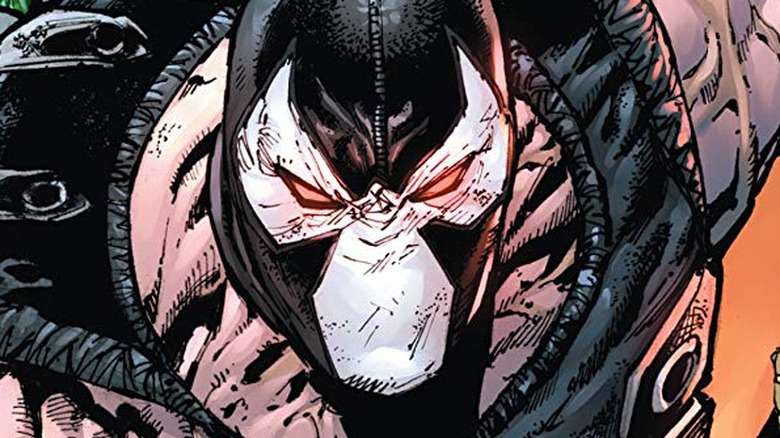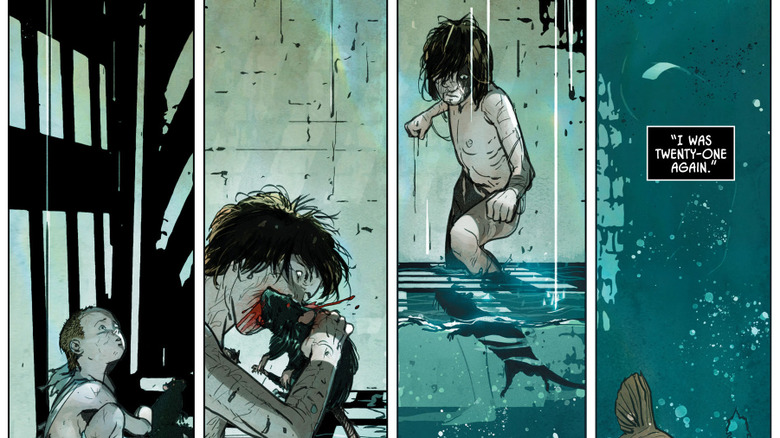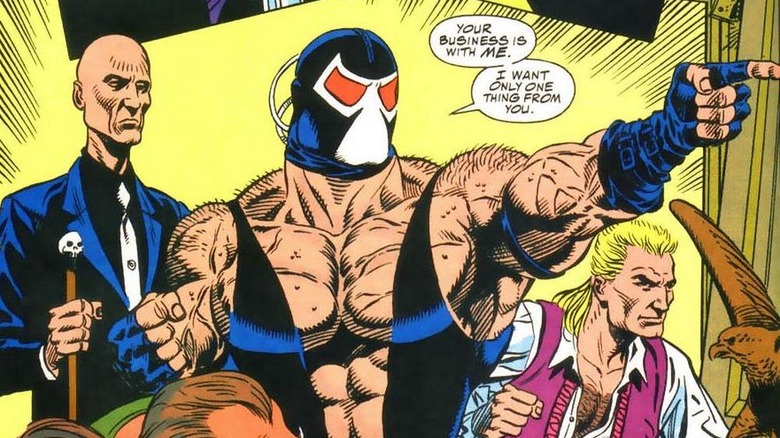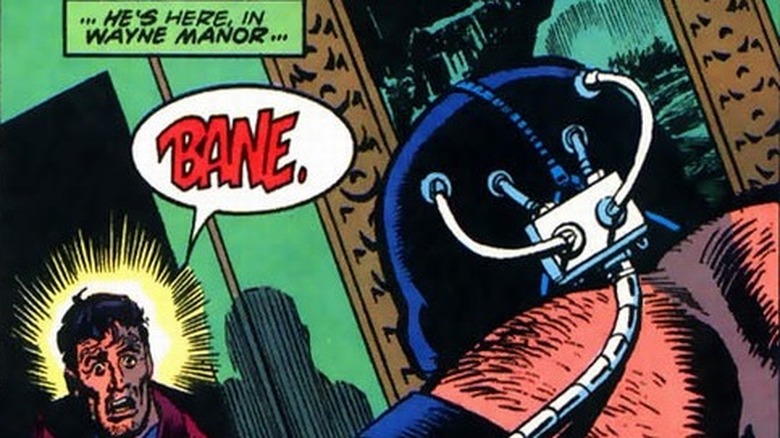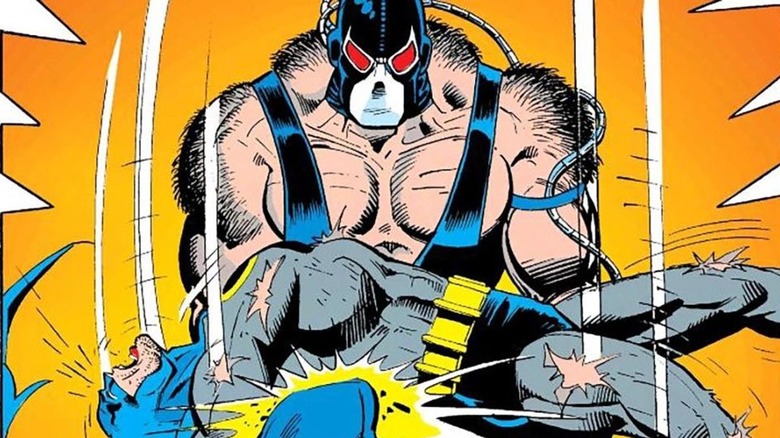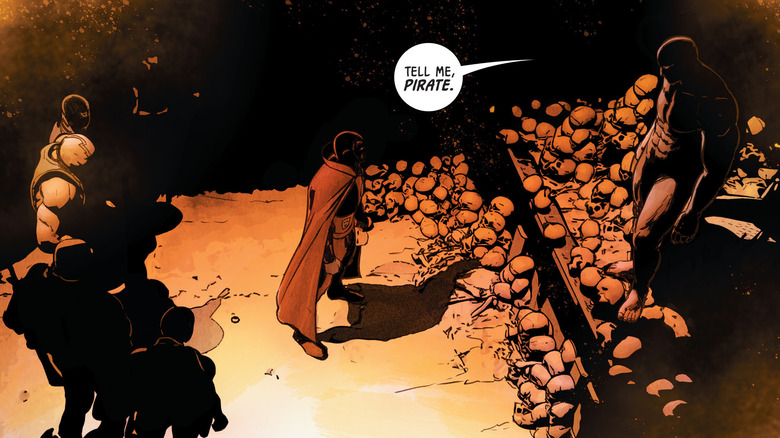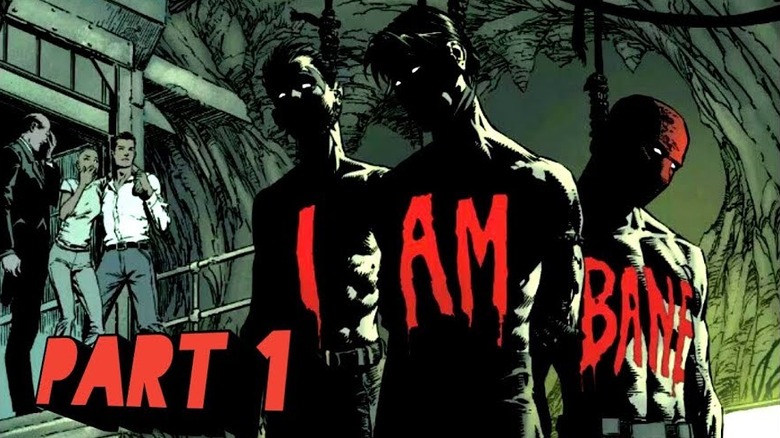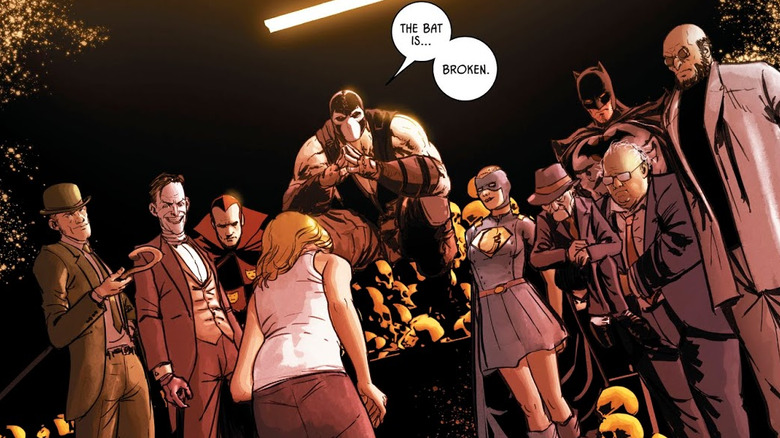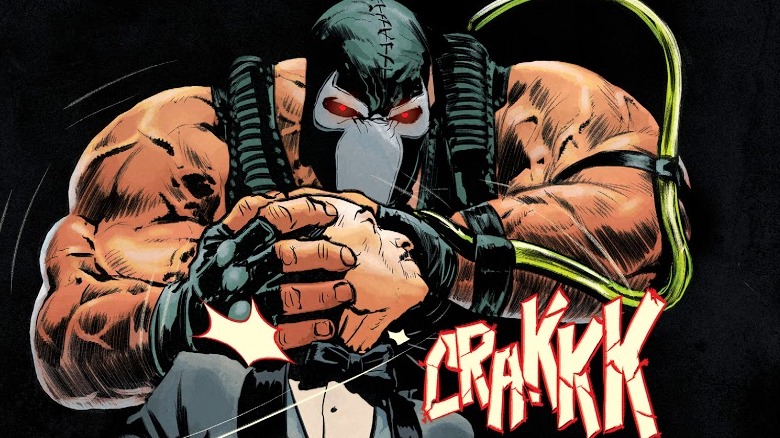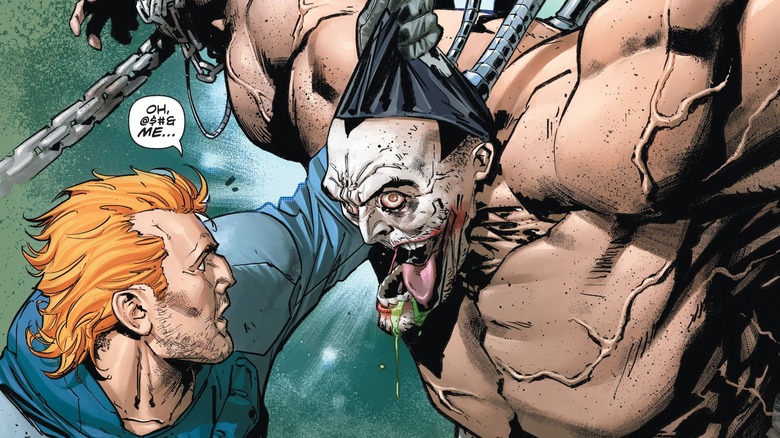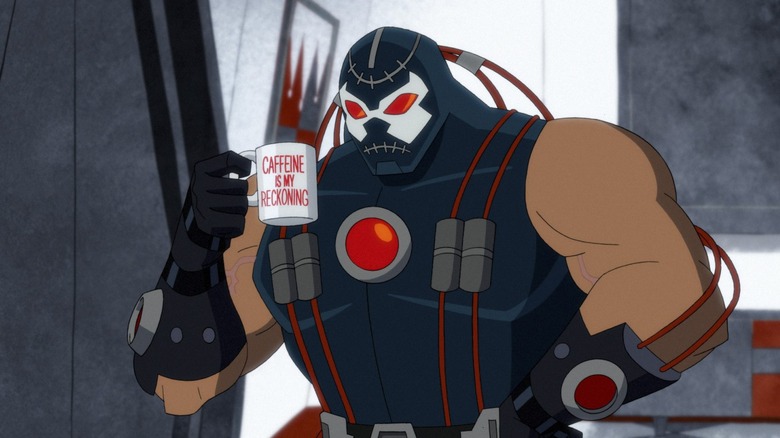The Dark History Of Bane
Out of every major superhero, Batman's frequently credited with having the wildest roster of villains — or "rogues gallery" as the kids call it. Gotham City is home to The Joker, who we think we can reasonably declare is the most popular comic book supervillain ever. It's also where Catwoman, The Riddler, The Penguin, Scarecrow, Poison Ivy, and Mr. Freeze all reside and plot their devious schemes. (Nowadays, Catwoman foils more devious schemes than she plots herself, but that's another story...)
A student of comic book history might observe that all the names we just mentioned mark their first appearances in the 1940s or 1960s. Strictly in terms of villains, most of the Bat baddies who emerge in '90s comics have gradually faded from the collective memory...except two: Bane and Harley Quinn. With all due respect to the onetime Dr. Harleen Quinzel, she has her charisma, cuteness, and a sympathetic backstory working on her behalf to keep her relevant. Bane has none of those attributes. He is an violent psychopath with some nasty chemical dependency issues and little, if any, redeeming value.
In other words, Bane is pretty dark. And yet, not unlike Harley, at least one major movie star is openly campaigning to play Bane next time a cinematic iteration of the homicidal muscleman is needed. How is such a reprehensible individual so enduring? Let's stare into the darkness of his history; maybe we'll learn something...
Bane's childhood was a prison. Literally!
Created by writers Chuck Dixon and Doug Moench and artist Graham Nolan, Bane arrives on the DC Comics scene at the onset of 1993's "Knightfall" event. "Batman: Vengeance of Bane #1" by Dixon and Nolan documents the future fiend's birth and upbringing in a the Peña Duro prison complex on the northeastern Caribbean nation of Santa Prisca. Due to a quirk in Santa Priscan law, baby Bane serves a life sentence from the moment he pops out of the womb on behalf on his father, a recently-deceased revolutionary fighter.
The future nefarious beefcake spends his childhood surrounded by violent criminals, and his adolescence forced to eat live rats in a solitary-confinement cell that floods every night. These circumstances influence Bane's emotional development about as well as you might expect.
Right around the time Bane has fully developed into an adult with a casual attitude about mass murder, scientists in the employ of the Santa Prisca military are using Peña Duro inmates as involuntary test subjects for the strength-and stamina-enhancing Venom formula. In addition to heightening athletic abilities, Venom was designed to crank up the body's adrenaline production and alter the physical makeup of the brain.
Once Bane survives the Venom tests, he immediately puts his new powers to use by escaping Peña Duro and killing at least one high-ranking prison official. Apparently, testing a potential super soldier formula on dangerous convicts is a really bad idea.
Bane moves to Gotham and immediately blows up Arkham
During Bane's time in Peña Duro, an acquaintance named Bird tells Bane tall tales of Gotham City, and the individual he calls its de facto ruler — Batman. As part of an evident self-imposed quest for dominance, Bane takes it upon himself to annihilate Batman promptly upon the end of his incarceration. Bird flees Peña Duro along with Bane, becomes his henchman, and attacks Gotham's crimefighters with trained birds, as one does.
Bane talks a hard game about his individual prowess and achievement, but it looks an awful lot like Bane wants Batman softened up before he swoops in for the big win. Shortly after his first encounter with the Caped Crusader, Bane uses a rocket launcher to blast supervillain-sized holes in the walls of Arkham Asylum in "Batman" #491.
The Joker, Scarecrow, Zsasz, The Ventriloquist, Firefly, and a score of others escape and inflict deadly chaos across Gotham. Batman must spread himself out very, very thin to put them all back in their padded cells. When Bane approaches Batman for the second time, it is ensured that Batman is already beyond exhausted, and therefore, much easier to beat up than he usually is.
Bane might tell you this is his way of breaking the Bat mentally as well as physically, but we're pretty sure Bane just didn't want to fight a Batman operating on a full eight hours of sleep.
Bane figured out Batman's secret identity real quick
Sometime following the surprise early release of every patient in Arkham, Batman rescues the mayor from a Joker and Scarecrow team-up and fights three of Bane's top accomplices in the same night. He barely makes it home, stumbles up the stairs from the Batcave, and who does he find waiting? You guessed it. On the final page of "Detective Comics" #663, it's Bane, just standing in Bruce Wayne's living room.
How did Bane put it together? "You could be no one else!" he declares. He offers no other context, but maybe he doesn't have to? When he first learns about Batman back in Peña Duro, he is told Batman "rules" Gotham. Maybe, if he takes that statement more literally than it's intended, he might start looking for the true identity of a mystery ruler among Gotham's most powerful and wealthy. If he finds out about the defining incident of Bruce Wayne's childhood — which he can do by checking literally any newspaper archive — then there's really nothing stopping him from putting two and two together.
Also, Batman kind of destroys any potential for plausible deniability by not changing out of his costume before exiting the cave. Perhaps Bane simply invades the home of Bruce Wayne for an unrelated reason, sees Wayne in the Bat outfit, and pretended he had the big secret figured out all along? We'll never know.
Bane broke Batman's back. It's kind of his thing
The comparison falls apart when we take 2012's "The Dark Knight Rises" into consideration, but for a while, Bane was pretty much Batman's answer to Superman's Doomsday. Both villains first appear in storylines designed to move established versions of a hero away from center stage, and those respective events — "Knightfall" and "The Death of Superman" — both rolled out in comic stores during the early-to-mid '90s. And much in the same way Doomsday, as a character, hasn't evolved beyond being a cipher who beat Superman to death once, Bane's single triumph against Gotham's guardian defined him for about 20 years worth of real world time.
After Bane confronts Batman in Wayne Manor and reveals his intention to rule Gotham, the pair of spandex-clad adversaries brawl down to the Batcave. Batman simply doesn't have enough left in the tank to withstand Bane's assault. The encounter ends with Bane lifting Batman over his head, and bringing him down full force horizontally across his knee. Batman's back goes "KRAKT."
Batman heals, and goes on to defeat Bane many, many times. During that period, breaking Batman's back was pretty much Bane's version of Al Bundy's four touchdowns in one game — a bygone accomplishment he never came close to topping. Luckily, Christopher Nolan and Tom Hardy came along and gave him a new sense of identity and purpose. Otherwise, Bane might have been stuck as a washed-up '90s character forevermore.
Eventually, Bane becomes the weird naked warlord of Peña Duro
Quite a while after the events of "Knightfall" — "quite a while" in this instance meaning more than 20 years of real world time and at least one reboot of the DC Comics timeline — Bane returns to Santa Prisca, and seems to become its de facto sovereign ruler. Whether or not he holds a position of any official political power is unclear, but largely irrelevant.
What is relevant is Bane lives in the Peña Duro prison complex, which is converted into a fortress and guarded by a literal army. As of "Batman" #9, published in 2016, Bane sits on a throne comprised entirely of human skulls, and he does not wear clothes. To regulate his moods and thereby manage his addiction to Venom, Bane keeps the Psycho Pirate on hand at all times. The Psycho Pirate can use his powers to make other people feel any emotion he wants, and he wants Bane to be happy, because an angry Bane might rip him in half like a phonebook.
What's darker than acquiring substantial power, only to devote that power to lounging around naked and entirely hairless on a pile of skulls, while forcing a Silver Age-style goofball supervillain to manipulate your feelings? Not much, we'll wager.
Bane strings up all the Robins
Out of necessity, we're got to abbreviate a whole bunch of writer Tom King's 85-issue "Batman" run here. On the plus side, at least that makes this list relatively light on spoilers.
At the onset of the arc titled "I Am Suicide," Batman needs access to Psycho Pirate's powers, so Batman invades Peña Duro with his own personal Suicide Squad recruited directly out of Arkham Asylum. A lot happens, then Batman defeats Bane and brings the Pirate to Gotham.
Bane, understandably miffed, heads to Gotham to retrieve his unlimited human Klonopin supply in the following arc, "I Am Bane." To inform Batman he means business, Bane overcomes and hangs Dick Grayson, Jason Todd, and Damian Wayne – all three active or former Robins – in the Batcave. (Batman really needs to figure out how to Bane-proof the Batcave. This is an ongoing problem.)
Batman transports Dick, Jason, and Damian up to Superman's Fortress of Solitude where they can recover far, far away from Bane. So while the physical damage wasn't permanent, the sight of two of his protégés and his son swinging from his ceiling definitely adds to Batman's laundry list of psychological scars.
Side note: Later on in "I Am Bane," our subject rampages through Arkham Asylum, encounters Two-Face, Man-Bat, Zsasz, Solomon Grundy, and several other villains, and ruthlessly trounces them all. This should settle any debate as to whether Bane can beat up most of Batman's rogues gallery.
To destroy Batman, Bane joins forces with...Batman
After Batman defeats him once again, Bane makes one more serious attempt to rid the world of the Caped Crusader. This time, rather than use his fists, he puts together an elaborate conspiracy involving the participation of numerous costumed criminals and adventurers — most notably, Batman.
In an alternate universe, Joe Chill shoots and kills Bruce Wayne instead of his parents, Thomas and Martha. This event drives Thomas to become the Batman of his world, and wage a one-man war on crime. It isn't entirely dissimilar to what we've grown accustomed to in the mainstream DC Universe. The key differences are this version of Batman — who we'll just call "Thomas Wayne" from here on out, to avoid confusion — is deeply insane and murders every criminal he defeats, even mostly-harmless petty crooks like Kite-Man.
Just like many other psychotic mass killers over the years, Thomas Wayne develops a bizarre obsession with Batman, and seeks Bane's help in a bid to ruin his alternate reality son's life.
Joining forces with Thomas Wayne does not pan out into the best decision Bane ever makes. But at least he gets to include an evil Batman with totally boss red vampire eyes among his gang of henchmen for a while.
Bane kills Alfred
One of the most graphic deaths of a major comic book character in recent years occurs in 2019's "City of Bane" arc. The story's primary villain is actually Thomas Wayne, so some readers argue that "City of Bane" is a bit of a misleading title. But we can't dispute the fact that Bane finally does something even worse to Batman than break his back.
Bane and Thomas Wayne pool their skills and resources, take Batman off the table, acquire an atom bomb and hold Gotham hostage under threat of nuclear annihilation, convert the city's criminals into an ironic police force via Psycho Pirate's mind control, and promise to murder Alfred Pennyworth if they so much as catch a glance of any Batman-adjacent crime fighters.
Damian Wayne — beyond overconfident as always — swings in to rescue his beloved butler despite the warning, and almost pulls it off! Damian defeats Gotham Girl — a Kryptonian-level metahuman, let's remember — as well as brainwashed cops Zsasz and Scarecrow, before an encounter with Thomas Wayne ends his winning streak. The Bane-Wayne alliance takes Damian prisoner, and true to his word, Bane cracks Alfred's neck like a celery stick right in front of his surrogate grandson.
Of course Alfred will be back sooner or later, 'cos comics. But the trauma of experiencing his own brutal execution is likely to inform his characterization for years, even after his inevitable resurrection. And for that, Alfred has Bane to thank.
Bane is dead
Perhaps the darkest part of Bane's history is its end...For the time being, at least.
In 2021's "Infinite Frontier" #1, a chemical attack seemingly perpetrated by the Joker befalls Arkham Asylum. Upon his arrival, Batman's tech only indicates 17 still-living individuals inside the building. As readers know from a few pages earlier, Bane is not among them.
Just like the other Arkham patients and staff who perished in the incident Gothamites refer to as "A-Day," plus countless victims of the Joker throughout the years, Bane dies with his face frozen in a horrible extra-large grin. The Joker has denied responsibly for the A-Day massacre. However, as far as Bane is concerned, the precise identity of the perpetrator is irrelevant, because Bane is dead.
In theory, this seems like a pretty anticlimactic demise for one of Batman's final boss-level antagonists. It wouldn't surprise us if the corpse we see in Arkham is an imposter or a clone, and Bane's back to his old self again within six months of real world time. Or maybe DC editors and executives made a decision to keep the onetime kingpin of Santa Prisca off the table for an extended period. For now, it looks like Bane's story ends the same way all of our stories will eventually end.
Bane might sound like Tom Hardy forevermore
After 2008's "Iron Man," Robert Downey Jr.'s performance of Tony Stark had a massive influence on how the character was portrayed in subsequent media. Essentially, writers and artists stopped thinking of Tony as a modern-day Howard Hughes, and started thinking of him as RDJ. A similar phenomenon may have unfolded for Bane thanks to Tom Hardy's portrayal in "The Dark Knight Rises."
Let's look at previous animated versions of Bane. In the appropriately-titled episode of "Batman: The Animated Series," "Bane," our subject, voiced by Henry Silva, speaks with a Latin American accent; his voice has few other distinctive elements. In the 1st season of "Young Justice," Danny Trejo offers an essentially similar, if slightly more menacing take.
These two TV programs aired in 1994 and 2011. "The Dark Knight Rises" premiered in 2012.
Now, let's listen to a 2019 animated Bane from "Harley Quinn," provided vocals by James Adomian. The South American accent is gone, and replaced by the less common Romani Gypsy accent introduced by Hardy in 2012's "TDKR." While "Harley Quinn" takes place in its own version of the DC Universe and certainly leans into the more over-the-top aspects of Hardy's Bane for comedy's sake, we wonder — has a RDJ-type effect set in here? Is Bane's Latin American accent gone for good?
At this point, only Matt Reeves and Bruce Timm know for sure.
